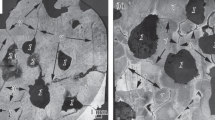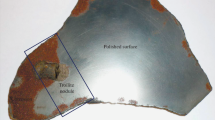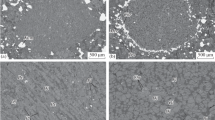Abstract
The petrography, mineral modal data and major and trace element compositions of 15 silicate inclusions in the Elga iron meteorite (chemical group IIE) show that these inclusions represent chemically homogeneous zoned objects with highly variable structures, reflecting the sequence of crystallization of a silicate melt during cooling of the metal host. The outer zones of inclusions at the interface with their metal host have a relatively medium-grained hypocrystalline texture formed mainly by Cr-diopside and merrillite crystals embedded in high-silica glass, whereas the central zones have a fine-grained hypocrystalline texture. Merrillite appears first on the liquidus in the outer zones of the silicate inclusions. Na and REE concentrations in merrillite from the outer zones of inclusions suggest that it may have crystallized as α-merrillite in the temperature range of 1300–1700°С. Merrillite tends to preferentially accumulate Eu without Sr. Therefore, strongly fractionated REE patterns are not associated with prolonged differentiation of the silicate melt source but depend on crystallization conditions of Н-chondrite droplets in a metallic matrix. The systematic decrease in Mg# with increasing Fe/Mn in bronzite may indicate partial reduction of iron during crystallization of the inclusion melt. The modal and bulk compositions of silicate inclusions in the Elga meteorite, as well as the chemical composition of phases are consistent with the model equilibrium crystallization of a melt, corresponding to 25% partial melting of H-chondrite, and the crystallizing liquidus phase, merrillite, and subsequent quenching at about 1090°С. Despite a high alkali content of the average weighted bulk inclusion composition, La/Hf and Rb/Th fall within the field of H chondrites, suggesting their common source. Our results reveal that silicate inclusions in the Elga (IIE) iron meteorite originated by mixing of two impact melts, ordinary chondrite and Ni-rich iron with а IIE composition, which were produced by impact event under near-surface conditions on a partially differentiated parent asteroid.
Similar content being viewed by others
References
E. Anders and N. Grevesse, “Abundances of the elements: meteoritic and solar,” Geochim. Cosmochim. Acta 53, 197–214 (1989).
J. Ando, “Phase diagrams of Ca3(PO4)2–Mg3(PO4)2 and Ca3(PO4)2–CaNaPO4 systems,” Bull. Chem. Soc. Jpn. 31, 201–205 (1958).
A. A. Ariskin, “Phase equilibria modeling in igneous petrology: use of COMAGMAT model for simulating fractionation of ferro-basaltic magmas and the genesis of high-alumina basalt,” J. Volcanol. Geotherm. Res. 90, 115–162 (1999).
A. A. Ariskin, M. I. Petaev, A. A. Borisov, and G. S. Barmina, “METEOMOD: a numerical model for the calculation of melting-crystallization relationships in meteoritic igneous systems,” Meteorit. Planet. Sci. 32, 123–133 (1997).
D. P. Blanchard and J. R. Budahn, “Remnants from the ancient crust: clasts from Consortium breccia 73255,” Proc. Lunar Planet. Sci. Conf. 10, 803–816 (1979).
D. P. Blanchard, J. W Jacobs., and J. C. Brannon, “Chemistry of ANT-suite and felsite clasts from consortium breccia 73215 and of gabbroic anorthosite 79215,” Proc. Lunar Planet. Sci. 8, 2507–2524 (1977).
D. D. Bogard, Garrison, D.H., and McCoy, T.J., “Chronology and petrology of silicates from IIE iron meteorites: evidence of a complex parent body evolution,” Geochim. Cosmochim. Acta 64, 2133–2154 (2000).
V. F. Buchwald, Handbook of Iron Meteorites. Their History, Distribution, Composition and Structure (University of California Press, Berkeley, 1975).
T. E. Bunch, K. Keil, and E. Olsen, “Mineralogy and petrology of silicate inclusions in iron meteorites,” Contrib. Mineral. Petrol. 25, 297–340 (1970).
A. J. Campbell and M. Humayun, “Trace element microanalysis in iron meteorites by laser ablation ICP-MS,” Anal. Chem. 71, 939–946 (1999).
L. Casanova, T. Graf, and K. Marti, “Discovery of an unmelted H-chondrite inclusion in an iron meteorite,” Science 268, 540–542 (1995).
R. N. Clayton T. K. Mayeda, E. Olsen, and M. Prinz, “Oxygen isotope relationships in iron meteorites,” Earth Planet. Sci. Lett. 65, 229–232 (1983).
M. I. D’yakonova, V. Ya. Kharitonova, and A. A. Yavnel, Chemical Composition of Meteorites (Nauka, Moscow, 1979) [in Russian].
A. M. Davis, “Volatile evolution and loss,” in Meteorites and the Early Solar System II, Ed. by D. S. Lauretta and H. Y. McSween, Jr. (Arizona Univ., Tucson, 2006), pp. 295–307.
R. T. Dodd “Olivine microporphyry in the St. Mesmin chondrite,” Meteoritics 11, 1–20 (1970).
M. Ebihara, Y. Ikeda, M. Prinz, “Petrology and chemistry of the Miles IIE iron II: chemical characteristics of the Miles silicate inclusions,” Antarc. Meteorite Res. 10, 373–388 (1997).
L. Grossman, “Refractory trace elements in Ca-Al-rich inclusions in the Allende meteorite,” Geochim. Cosmochim. Acta 37, 1119–1140 (1973).
W. Hsu, “Ion probe study of silicate inclusions from Colomera (IIE) iron Meteorite: the rare earth element persective,” Acta Geol. Sinica 78, 1060–1074 (2004).
W. Hsu, “Rare earth element geochemistry and petrogenesis of Miles (IIE) silicate inclusions,” Geochim. Cosmochim. Acta 67, 4807–4821 (2003).
Y. Ikeda and M. Prinz, “Petrology of silicate inclusions in the Miles IIE iron,” Proc. NIPR Symp. Antarct. Meteorites 9, 143–173 (1996).
K. P. Jochum, B. Stoll, J. M. Friedrich, M. Amini, St. Becker, M. Dücking, D. S. Ebel, J. Enzweiler, Hu Ming-Yue, D. Kuzmin, R. Mertz-Kraus, W. E. G. Müller, J. Regnery, A. V. Sobolev, Wang Xiaohong, and Zhan Xiu-Chun, “Laser ablation-inductively coupled plasma-mass spectrometry and its application in geochemistry, cosmochemistry and environmental research,” Rock and Mineral Analysis 28 (1), 53–68 (2009).
B. L. Jolliff, R. L. Korotev, and L. A. Haskin, “Geochemistry of 2–4mm particles from Apollo 14 soil (14161) and implications regarding igneous components and soil-forming processes,” Proc. Lunar and Planet. Sci. Conf. 21, 193–219 (1991).
B. L. Jolliff, L. A. Haskin, R. O. Colson, and M. Wadhwa, “Partitioning in REE-saturating minerals: theory, experiment, and modelling of whitlockite, apatite, and evolution of lunar residual magmas,” Geochim. Cosmochim. Acta 57, 4069–4094 (1993).
L. L. Kashkarov, N. N. Korotkova, and A. K. Lavrukhina, “Relict radiation of iron meteorite by the low-energy heavy nuclei of cosmic rays,” Dokl. Akad. Nauk SSSR 221, 198–200 (1975).
N. R. Khisina, S. N. Teplyakova, R. Wirth, V. G. Senin, A. A. Averin and A. A. Shiryaev, “Carbon-bearing phases in shock-induced melt zones of the Elga Meteorite,” Geochem. Int. 55 (4), 317–329 (2017).
K. Kitts and K. Lodders, “Survey and evaluation of eucrite bulk compositions,” Meteorit. Planet. Sci. 33, 197–A213 (1998).
A. N. Krot and J. T. Wasson, “Silica-merrihueite/roedderite- bearing chondrules and clasts in ordinary chondrites: new occurrences and possible origin,” Meteoritics 29 (5), 707–718 (1994).
G. Kurat, E. Zinner, and M. E. Varela, “Trace element studies of silicate-rich inclusions in the Guin (UNGR) and Kodaikanal (IIE) iron meteorites,” Meteorit. Planet Sci. 42, 1441–1463 (2007).
L. G. Kvasha, Yu. G. Lavrent’ev, and N. V. Sobolev, “Silicate inclusions and signs of impact metamorphism in the Elga octahedrite,” Meteoritika 33, 143–147 (1974).
D. H. Lindsley D. J. Andersen, “Two pyroxene thermometer,” 13th Proc. Lunar and Planet. Sci. Conf. in J. of Geoph. Research 88, A887–A906 (1983).
A. A. Maslov, R. V. Ostvald, V. V. Shagalov, E. S. Maslova, and Yu. S. Gorenyuk, Chemical Technology of Niobium and Tantalum (Tomsk Politekhn Univ., Tomsk, 2010) [in Russian].
T. J. McCoy, “Silicate-bearing IIE irons: Early mixing and differentiation in a core-mantle environment and shock resetting of ages,” Meteoritics 30, 542–543 (1995).
H. J. Melosh, Impact Cratering: A Geologic Process (Oxford, 1995).
D. Mittlefehldt, T. McCoy, C. Goodrich, and A. Kracher, “Non-Chondritic Meteorites from Asteroidal Bodies,” Ed. by J. J. Papike, in Planet. Mater. 4–7 (1998).
R. W. Morris, G. J. Taylor, H. E. Newsom, K. Keil, and S. R. Garcia, “Highly evolved and ultramafic lithologies from Apollo 14 soils,” Proc. Lunar Planet. Sci. Conf. 20, 61–75 (1990).
E. Olsen, A. Davis, R. J. Clarke, Jr., L. Schultz, and H. W. Weber, “Watson: a new link in the IIE iron chain,” Meteoritics 29, 200–213 (1994).
Eu. G. Osadchii, G. V. Baryshnikova, and G. V. Novikov, “The Elga meteorite: silicate inclusion and shock metamorphism,” 12th Lunar Planet Sci. 1049–1068 (1981).
N. J. G. Pearce, W. T. Perkins, J. A. Westgate, M. P. Gorton, S. E. Jackson, C. R. Neal, and S. P. Chenery, “A compilation of new and published major and trace element data for NIST SRM 610 and NIST SRM 612 glass reference materials,” Geostandards Newsletter: The J. Geostandards and Geoanalysis 21, 115–144 (1997).
Phase Diagrams of Fe-based Double and Multicomponent Systems. A Reference Book, Ed. by O. A. Banykh and M. E. Drits (Metallurgiya, Moscow, 1986) [in Russian]
L. N. Plyashkevich, “Some data on composition and structure of iron meteorite,” Meteoritika 22, 51–60 (1962).
M. Prinz C. E. Nehru, J. S. Delaney, G. E. Harlow, and R. L. Bedell, “Modal studies of mesosiderites and related achondrites, including the new mesosiderite ALHA 77219,” Proc. Lunar Sci. Conf. 11, 1055–1071 (1980).
M. Prinz, C. E. Nehru, J. S. Delaney, M. Weisberg, and E. Olsen, “Globular silicate inclusions in IIE irons and Sombrerete: highly fractionated minimum melts,” 14th Lunar Planet. Sci. 618–619 (1983).
J. E. Quick, A. L. Albee, M.-S. Ma, A. V. Murali, and R. A. Schmitt, “Chemical composition and possible immiscibility of two silicate melts in 12013,” Proc. Lunar Sci. Conf. 8, 2153–2189 (1977).
A. E. Rubin, “Mineralogy of meteorite groups,” Meteoritics 32, 231–247 (1997).
A. E. Rubin, E. A. Jerde, P. Zong, and J. T. Wasson, “Properties of the Guin ungrouped iron meteorite: The origin of Guin and of group-IIE irons,” Earth. Planet. Sci. Lett. 76, 209–226 (1986).
A. Ruzicka and M. Hutson, “Comparative petrology of silicates in the Udei Station (IAB) and Miles (IIE) iron meteorites: implications for the origin of silicate-bearing irons,” Geochim. Cosmochim. Acta 74, 394–434 (2010).
A. Ruzicka, “Silicate-bearing iron meteorites and their implications for the evolution of asteroidal parent bodies,” Chem. Erde 74, 3–48 (2014).
A. Ruzicka, G. W. Fowler, G. A. Snyder, M. Prinz, J. J. Papike, and L. A. Taylor, “Petrogenesis of silicate inclusions in the Weekeroo Station IIE iron meterorite: differentiation, remelting and dynamic mixing,” Geochim. Cosmochim. Acta 63, 2123–2143 (1999).
A. Ruzicka, M. Hutson, and C. Floss, “Petrology of silicate inclusions in the Sombererete ungrouped iron meteorite: implications for the origins of IIE-type silicatebearing irons,” Meteorit. Planet. Sci. 41 (11), 1797–1831 (2006).
E. R. D. Scott and J. T. Wasson, “Chemical classification of iron meteorites–VIII.Groups IC, IIE, IIIF and 97 other irons,” Geochim. Cosmochim. Acta 40, 103–115 (1976).
L.-K. Sha, “Whitlockite solubility in silicate melts: some insights into lunar and planetary evolution,” Geochim. Cosmochim. Acta 64, 3217–3236 (2000).
G. A. Snyder, L. A. Taylor, Y.-G. Liu, and R. A. Schmitt, “Petrogenesis of the western highlands of the Moon: Evidence from a diverse group of whitlockite-rich rocks from the Fra Mauro Formation,” Proc. Lunar Planet. Sci. 22, 399–416 (1992)
H. Takeda, W. Hsu, and G. R. Huss, “Mineralogy of silicate inclusions of the Colomera IIE iron and crystallization of Cr-diopside and alkali feldspar from a partialmelt,” Geochim. Cosmochim. Acta 67, 2269–2287 (2003a).
H. Takeda, D. D. Bogard, M. Otsuki, and T. Ishii, “Mineralogy and Ar–Ar age of the Tarahumara IIE iron, with reference to the origin of alkali-rich materials,” NIPR Annual Meeting 16 (2003b).
S. N. Teplyakova, M. Humayun, C. A. Lorenz, and M. A. Ivanova, “A Common Parent for IIE Iron Meteorites and H Chondrites,” 43st Lunar Planet. Sci. Conf. pdf#1130.pdf (2012).
S. N. Teplyakova, “Evolution of molten material in iron cores of small planets,” Solar Syst, Res. 45 (6), 515–522 (2011).
S. N. Teplyakova, and N. N. Kononkova, “Evaluating of cooling rate of the Elga iron meteorite (IIE),” in Thirteen International Conference on Physicochemical and Petrophysical Studies in the Earth’s Science (2012), pp. 258–261.
S. N. Teplyakova, N. R. Khisina, V. V. Artemov, and A. L. Vasil’ev, “Nanomineralogy of dendritic inclusions in the Elga iron meteorite,” Zap. Vseross. Mineral. O-va 141 (2), 42–52 (2012).
W. E. Tröger, Optical Determination of Rock-Forming Minerals (Schweizerbartscge Verlagsbuchhandlung, Stuttgart, 1979).
F. Ulff Møller, K. L. Rusmussen, M. Prinz, H. Palm, and B. Spettel, “Magmatic activity on the IVA parent body: evidence from silicate-bearing iron meteorites,” Geochim. Cosmochim. Acta 59, 4713–4728 (1995).
E. Van Achterbergh, C. G. Ryan, S. E. Jackson, and W. L. Griffin, “Data reduction software for LA-ICPMS: appendix,” in Laser Ablation—ICP-Mass Spectrometry in the Earth Sciences: Principles and Applications, Ed. by P. J. Sylvester, Mineral. Ass Canada Short Course Ser. 29, 239–243 (2001).
V. I. Vronskii, “On find of the Elga iron meteorite,” Meteoritika 22, 47–50 (1962).
D. Walker M. A. Powell, D. E. Lofgren, and J. F. Hays, “Dynamic crystallization of a eucrite basalt,” Proc. Lunar Planet. Sci Conf. 9th 1369, 13–91 (1978).
D. Ward, A. Bischoff, J. Roszjar, M. J. Whitehouse, “Trace element inventory of meteoritic of Ca-phosphates,” 47st Lunar and Planet. Sci. Conf. pdf #1456 (2016).
P. H. Warren, E. A. Jerde, and G. W. Kallemeyn, “Pristine Moon rocks: a "large” felsite and a metal-rich ferroan anorthosite,” Proc. Lunar. Planet. Sci. Conf. 17th in J. Geophys. Res., 92, E303–E313 (1987)
P. H. Warren, G. J. Taylor, K. Keil, D. N. Shirley, and J. T. Wasson, “Petrology and chemistry of two "large” granite clasts from the Moon,” Earth Planet. Sci. Lett. 64, 175–185 (1983)
G. J. Wasserburg, H. G. Sanz, and A. E. Bence, “Potassium feldspar phenocrysts in the surface of Colomera, and iron meteorite,” Science 161, 684–687 (1968).
J. T. Wasson, “Ni, Ga, Ge and Ir in the metal of iron meteorites with silicate inclusions,” Geochim. Cosmochim. Acta 34, 957–964 (1970).
J. T. Wasson and G. W. Kallemayn, “Composition of chondrites,” Phil. Trans. R.S. London. A 328, 535–544 (1996).
J. T. Wasson, J. Willis, C. M. Wai, and A. Kracher, „Origin of iron meteorite groups IAB and IIICD,” 11th Lunar Planet. Sci., 25–26 (1980).
Author information
Authors and Affiliations
Corresponding author
Additional information
Original Russian Text © S.N. Teplyakova, C.A. Lorenz, M.A. Ivanova, N.N. Kononkova, M.O. Anosova, K.M. Ryazantsev, Yu.A. Kostitsyn, 2018, published in Geokhimiya, 2018, No. 1, pp. 3–27.
Rights and permissions
About this article
Cite this article
Teplyakova, S.N., Lorenz, C.A., Ivanova, M.A. et al. Mineralogy of silicate inclusions in the Elga IIE iron meteorite. Geochem. Int. 56, 1–23 (2018). https://doi.org/10.1134/S0016702918010081
Received:
Accepted:
Published:
Issue Date:
DOI: https://doi.org/10.1134/S0016702918010081




